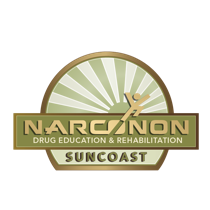We at the Suncoast Rehab Center saw the news about Lil’ Wayne being in the hospital, and have seen the speculation that he may have gotten back onto “sippin’ syrup”, which is a codeine-based drug that he has rapped about in his music, and which he publicly said goodbye to in 2010.

This made me think about codeine and all of its various forms. Addiction to mixtures which have codeine in them has been a huge problem in the Southern rapper community; with rappers like DJ Screw (Robert Davis), who rapped about using codeine in his song “Sippin Codeine” – and overdosed on the mix of codeine and an antihistamine (which is a drug used to treat allergies) that makes up “sippin’ syrup” or “drank”. Pimp C (Chad Lamont Butler) also died from this mixture in Los Angeles in 2007.
So, what is codeine, and how is it addictive? What most people know is that it’s an ingredient in many cough syrups that you can only get from your doctor, and the doctor usually gives it to you when you have what is called a “non productive” cough, which means the cough isn’t bringing up any mucus. Codeine in this case is used to suppress the cough so that you don’t have to go through unnecessary and painful coughing.
Codeine is an opioid pain medication – which means that it comes from opium. Like all opiod drugs, it can be addicting. (Another drug that comes from opium is heroin.) Because codeine is an opiate, it can cause breathing problems, especially when mixed with other drugs that slow down breathing or relax a person– like alcohol. Additionally, codeine is normally only prescribed in small daily dosages for coughs and for pain. It is typically taken in larger doses when used by an addict to get high.
Codeine is dangerous to use with other medications that slow breathing and heart rate down, such as some pain medications, sleeping pills, muscle relaxants. Additionally, if a person has asthma, problems with breathing while they sleep, liver or kidney problems, low blood pressure, mental illness, have been told they can easily become addicted to things or many other physical problems, they should not take codeine.
Codeine can be misused or abused in several different ways.
One of the ways that is becoming very popular, and which is mentioned above, is a mix of an antihistamine (allergy medication), codeine and either alcohol or soda. Sometimes fruit candy is added to make the drink taste better. This mix is called different names: sippin’ syrup, drank, purple stuff, oil, lean, mud, and more. Usually when a drug dealer asks if you want some, they often ask if you “need an oil change”.
Many rappers have become addicted to this drug and carry Styrofoam cups as a symbol that they are using the drug.

Another way a person can abuse codeine is by drinking cough syrup either by itself or mixed with alcohol. Cough syrup with codeine in it can only be bought by visiting a doctor, so some people drink the type of cough syrup you can buy in the store. This type of cough syrup has a drug in it that helps a person stop coughing. The drug is called dextromethorphan – or DXM for short. Abuse of DXM is different than abuse of codeine, but is still dangerous and can cause hallucinations, paranoia, high blood pressure, coma, seizures, brain damage, and death.
Codeine is also abused by injecting it into your veins, by taking it in pill form, and even by using it as a suppository.
Codeine has many side effects. The more minor side effects are dizziness, light-headedness, faintness, nausea, and vomiting. More serious side effects include severe weakness, mood changes, extreme dizziness, difficulty breathing, low blood pressure, slowed heart rate, and seizures.
If you know anyone suffering from addiction to codeine or to “sippin’ syrup”, contact us today at 877-850-7355. We can help them overcome addiction with our drug-free program.
Refs: ABC News, Buzzle.com, Drugs.com, Kidshealth.org, Narconon.org, Addictionsearch.com, Guardian UK, MTV.com, Hollywoodlife.com, SLAM Online
